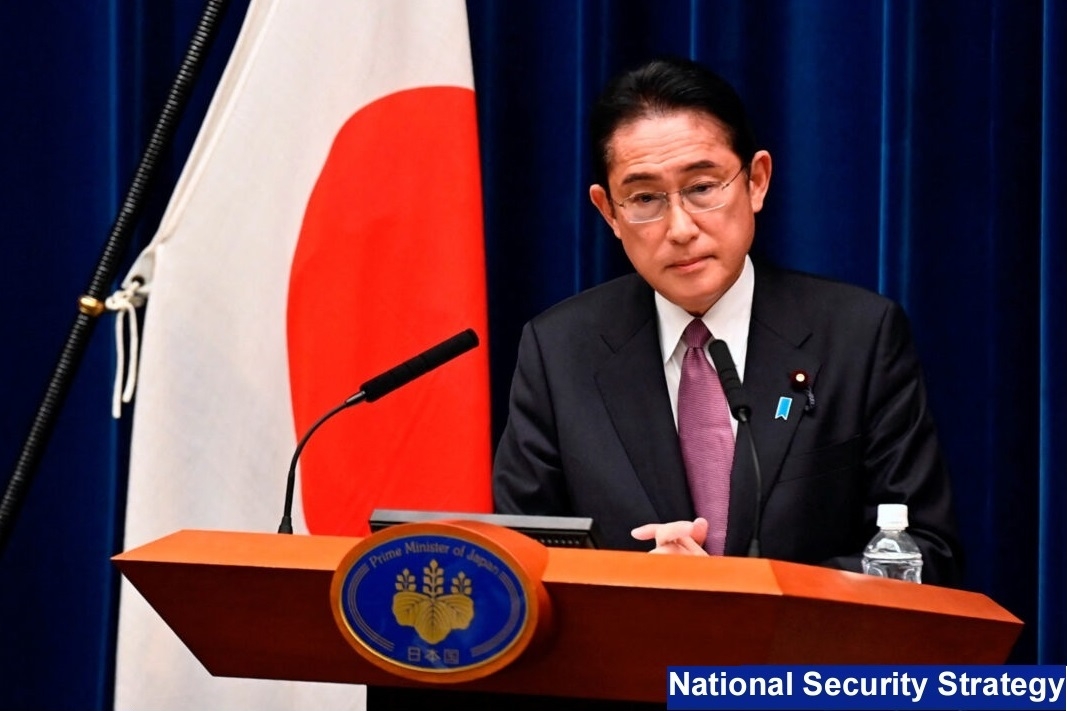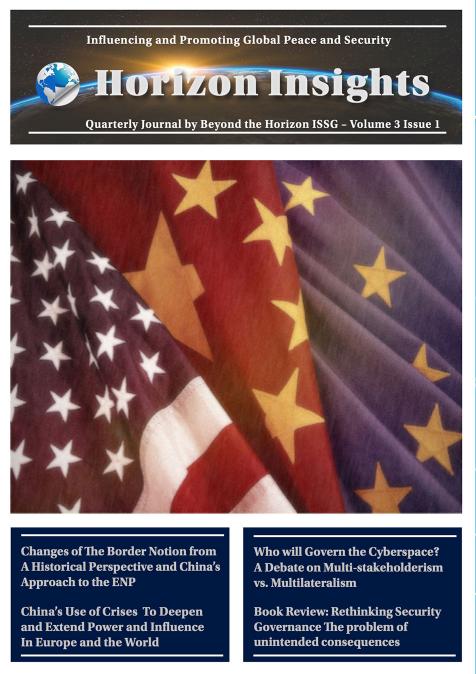Publications /
Opinion
This opinion was originally published in japanupclose.web-japan.org
On December 16, 2022, the Japanese government approved three important defense documents. The first is the National Security Strategy, which defines the general lines of the country's defense policy for the next decade. The second is the National Defense Strategy, which sets defense objectives and defines the means to achieve them. The third is the Defense Construction Program, which determines total defense spending, and the volume of major equipment purchases over the next 5 to 10 years. Together, these three documents constitute Tokyo's overall defense strategy, policy, and objectives, which take a tougher tone than its previous national security strategy, first published in 2013.

The New Japan's National Security Strategy (NSS)
The most important of the three documents is the NSS, which sets out diplomatic and defense strategies for the next 10 years. Its revision marks a major turning point in Japan's national security policy after World War II. Japan's National Security Strategy (NSS) and Active Cyber Defense (ACD) Project represent critical elements of Japan's efforts to safeguard its national interests and defend against emerging security threats in the digital age. Both initiatives underscore Japan's commitment to adapting its security posture to face evolving challenges, particularly in the realm of cyberspace. First, Japan's National Security Strategy serves as a comprehensive framework outlining Japan's security objectives, priorities, and strategies to protect its sovereignty, territorial integrity, and national interests. This reflects Japan's recognition of the increasingly complex and interconnected nature of modern security threats, including traditional military challenges as well as non-traditional threats such as cyberattacks, terrorism, and natural disasters.
Japan's Active Cyber Defense Strategy in a Connected World
In parallel, the Active Cyber Defense (ACD) project represents Japan's recognition of the growing significance of cybersecurity in ensuring national security and economic resilience. As a technologically advanced nation heavily reliant on digital infrastructure, Japan faces increasing cyber threats from state and non-state actors seeking to disrupt its critical systems and steal sensitive information...
In an ever-changing global landscape, cybersecurity has become one of the top concerns for governments and organizations around the world. Japan, recognizing the challenges posed by cyber threats, has developed an active defense strategy to protect its national interests. The ACD project is designed to enhance Japan's ability to detect, prevent, and respond to cyberattacks in real time through a combination of defensive measures, intelligence sharing, and public-private collaboration. It aims to strengthen Japan's cyber defense posture, deter adversaries, and minimize the impact of cyber incidents on its government, businesses, and society at large.
Japan's active defense strategy is based on several fundamental principles. First of all, the country recognizes the crucial importance of international cooperation in combating cyber threats. As a major player on the global stage, Japan is committed to strengthening partnerships with other nations, international organizations, and the private sector to share threat information, coordinate joint actions, and develop common standards. to ensure the security of global cyberspace. In March 2024, Google created its first cyber defense center dedicated to Asia Pacific in its Japanese premises located in Tokyo. The American giant's objective is to promote research on measures to adopt in the face of cyber threats while training experts in cyber defense.
Additionally, Japan is investing heavily in developing advanced defensive capabilities to counter sophisticated cyberattacks. This includes establishing rapid detection and response systems, strengthening critical infrastructure, such as power grids and communications systems, and training highly qualified cybersecurity experts. By taking a proactive approach, Japan seeks to anticipate and neutralize potential threats before they materialize.
Another crucial aspect of Japan's active defense strategy is public awareness of cyber risks. By educating citizens on good IT security practices and encouraging the adoption of protective measures, Japan aims to strengthen society's resilience to cyber threats. And finally, Japan strives to promote responsibility in its cyber defense efforts. The government works closely with the private sector to develop policies and regulations to protect data and ensure the confidentiality of information.
In conclusion, Japan's active defense strategy reflects its commitment to protecting its national interests in an increasingly connected world. By taking a proactive approach, strengthening international cooperation, investing in advanced defensive capabilities, and raising public awareness, Japan is positioning itself as a leader in combating cyber threats and as a reliable partner in promoting stability and security. online security.
The Features of the new Strategies
Besides the NSS, the other two documents are new, the National Defense Strategy (NDS) that replaces the National Defense Program Guideline (NDPG), which defines the defense strategy of the Japan Self-Defense Forces (JSDF) for the next decade, setting national security objectives and describes the approaches, objectives, and defense approaches as well as the means to achieve them). Likewise, the Medium-Term Defense Program (MTDP) becomes the DBP, a ML-term reinforcement program aimed at achieving the level of defense capability required by the PDN.
The three documents were released in 2013 during the 2nd Abe administration. The NDPG and MTDP were revised in 2018, marking the first simultaneous revision of all three documents. The 2018 revision of the NDPG was the fourth in 15 years. From now on, the government plans to revise simultaneously the three documents every ten years. These three documents should be seen as a historic change in Japan's defense policy. The objectives of the NSS and NDS are focused on strengthening defense capabilities. They also support the private sector to prevent critical national security information leaks.
The main changes are: it highlights fundamental changes in the security environment, particularly China's growing military power (as a threat to its security); 2) calls for increasing the defense budget to 2% of GDP; 3) plans to acquire missiles with a range of approximately 1,000 km with counterattack capability; 4), plans to introduce active cyber defense; 5) encourages the acquisition of unmanned weapons, 6) and supports the expansion of defense equipment exports.
The reasons for revisions are multiple: the rise of China, hybrid warfare in Ukraine, information warfare involving tactics from other countries, and cyberattacks sponsored by countries. The revision of the three documents aims to clarify Japan's responsibility, including maintaining counterattack capabilities, previously non-existent in Japan, and increasing the defense budget to 2% of GDP by 2027 (usually, Japan set the threshold of 1% of GDP since 1976).
Following the new NSS, the Japanese Foreign Ministry plans to use AI to improve surveillance of the information space and strengthen intelligence analysis. Similarly, the Ministry of Defense is also planning to implement an automatic information collection and analysis system using AI technology to understand the information warfare situation. Furthermore, several laws will be revised to implement active cyber defense. Likely, telecommunications legislation as well as that prohibiting unauthorized access to computers will be revised in the near future to allow the Japanese government to carry out administrative interceptions, an area already permitted in Western countries but not in Japan. Japan is strengthening its defense posture while seeking to promote digital transformation in the defense realm.
Overview of the Japan threat landscape
Japan, as an archipelago, is bordered by the Sea of Okhotsk to the north, the Sea of Japan to the west, the East China Sea and the Philippine Sea in the south, and the Pacific Ocean to the East. It stretches from Russia in the north to Taiwan and the Philippines in the south, to China and the two Koreas along the West coasts of Asia. It has 14 125 islands, of which 421 are inhabited. The expansion of the Empire of Japan from 1870 to 1942 left several historical border disputes unresolved: the Kuril Islands dispute between Japan and Russia, called Minami-Chishima in Japan and known as the Northern Territories; the Liancourt Rocks dispute between Japan and South Korea also called the Takeshima in Japan or Dokdo in Korea; the Senkaku Islands, claimed by China and Taiwan as Diàoyútái Qúndǎo; and the Exclusive Economic Zone of the Japanese “island” of Okinotori-shima, contested by China.
According to the document, the global security environment and challenges are particularly acute in the Indo-Pacific region, where Japan is located, and may become more serious in the future.
In addition, Japan faces threats and challenges of various types and intensities, such as unilateral changes to the status quo and such attempts in the East and South China Seas and other areas, piracy, terrorism, the proliferation of weapons of mass destruction, and natural disasters. From a geopolitical standpoint, Japan confronts substantial challenges. These challenges relate to regional dominance, its strategic alliances with QUAD and NATO, as well as ongoing territorial disputes.
Security in the Indo-Pacific Region: An Essential Pillar of the strategy
As per the document, the global security landscape and the challenges outlined above hold particular significance in the Indo-Pacific region, where Japan is situated. Within this context, Japan contends with an array of threats and challenges varying in type and intensity, piracy, terrorism, the proliferation of weapons of mass destruction, and natural disasters. Anchored by the vision of a Free and Open Indo-Pacific (FOIP), Japan recognizes the critical imperative of striving to actualize a free and open international order predicated on the rule of law in the Indo-Pacific region. This entails ensuring regional peace and stability through collaboration with its allies, like-minded nations, and other stakeholders.
However, while Japan's NSS and ACD projects represent important steps in addressing contemporary security challenges, they also face several inherent limitations and challenges. These include the need for greater international cooperation, adaptation to the rapid pace of technological change, and emerging cyber threats. Moreover, Japan's NSS must navigate complex geopolitical dynamics, including regional tensions, territorial disputes, and the evolving security landscape in the Indo-Pacific region, as well as the challenges posed by transnational threats such as terrorism, piracy, and natural disasters.
In conclusion, Japan's National Security Strategy and Active Cyber Defense project represent important initiatives aimed at enhancing Japan's security resilience and adapting to emerging threats in the digital age. While they reflect Japan's commitment to proactive security measures, their effectiveness will depend on the ability to address inherent challenges and adapt to evolving circumstances in an increasingly uncertain and complex security environment.





